 Technology peripherals
Technology peripherals
 AI
AI
 Google RT-1 model asks a robot to do several jobs, with a success rate of 97% for 700 instructions
Google RT-1 model asks a robot to do several jobs, with a success rate of 97% for 700 instructions
Google RT-1 model asks a robot to do several jobs, with a success rate of 97% for 700 instructions
Many recent advances in multiple subfields of machine learning (ML) research, such as computer vision and natural language processing, are built on leveraging large, diverse data sets and representations that can efficiently absorb all the data. Model.
However, this high-performance model method has relatively few applications in the field of robotics.
The reason is simple. First, the lack of large-scale and diverse robot data limits the model’s ability to absorb a wide range of robot experience.
Second, there is a lack of expressive, scalable, and fast enough real-time inference models that can learn from such datasets and generalize effectively.
This time, Google’s Robotics Transformer 1 (RT-1 for short) is a multi-task model that can label robot input and output actions (e.g., camera images, tasks instructions and motor commands) to enable efficient inference at runtime and enable real-time control.
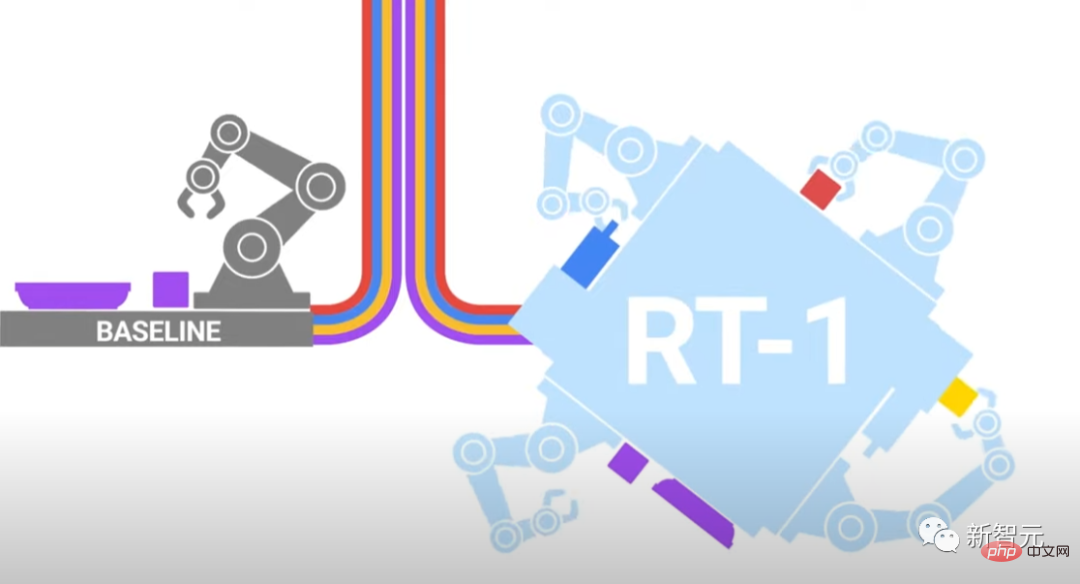
RT-1 absorbs a large amount of data to make the robot competent in a variety of tasks in different environments, thereby improving machine performance and generalization Ability
Simply put, it means letting a robot do several jobs at the same time.
The model was trained on a large real-world robotics dataset containing 130k episodes, covering more than 700 tasks, using 13 machines from Everyday Robots (EDR) The robots were collected over a period of 17 months.
The results show that RT-1 can significantly improve zero-shot generalization to new tasks, environments, and objects compared to existing techniques.
The editor has thoughtfully placed the Github link below. If you are interested, please go and have a look.
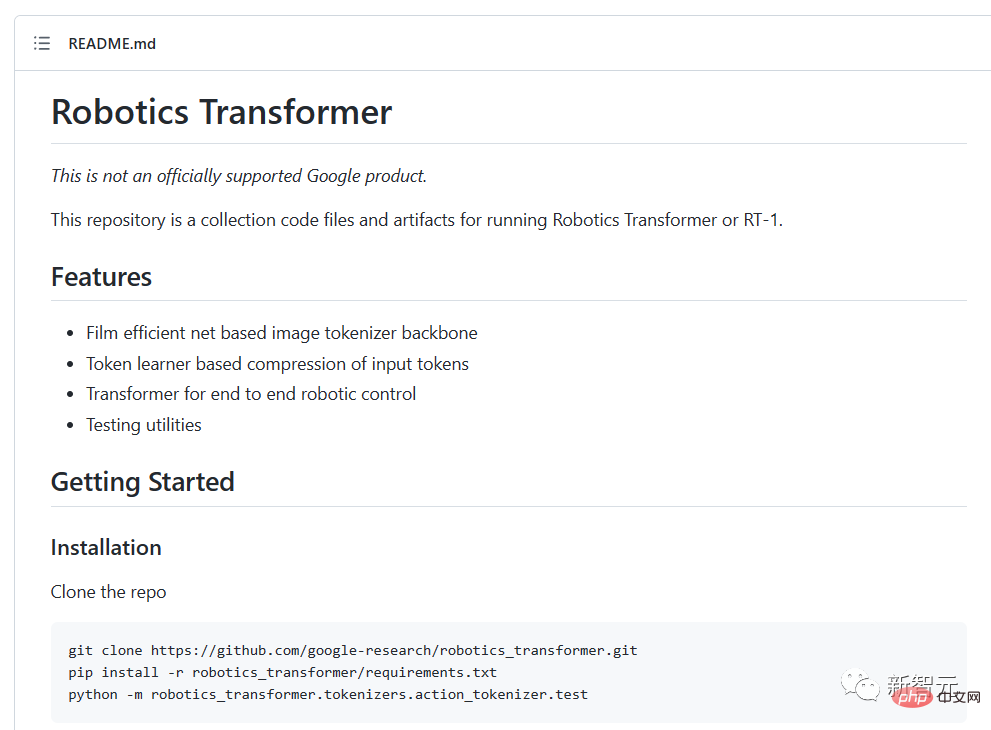
##https://github.com/google-research/robotics_transformer
RT-1 model specific principleRT-1 is built on the Transformer architecture. It can obtain the image history from the robot's camera and take the task description expressed in natural language as input, and output it directly at the same time. Tokenized actions.
The architecture of RT-1 is similar to that of a decoder-only sequence model trained against a standard categorical cross-entropy objective with causal masking.

The model takes as input text instructions and a set of images, encoding them into tokens through the pre-trained FiLM EfficientNet model, And compress it through TokenLearner, and then output the action tag through Transformer.
Its main functions include: Image Tokenization, Action Tokenization and Token Compression.
- Image tokenization: We pass the image through the EfficientNet-B3 model pre-trained on ImageNet, and then flatten the resulting 9×9×512 spatial feature map into 81 tokens. The image tokenizer is conditioned on natural language task instructions and extracts task-relevant image features early on using a FiLM layer initialized to identity.
- Action tokenization: The robot’s action dimension is the 7 variables of arm movement (x, y, z, roll, pitch, yaw, clamp open) , 3 basic motion variables (x, y, yaw), and an additional discrete variable to switch between the three modes.
- Token compression: The model adaptively selects soft combinations of image tokens based on their impact on learning using the element attention module TokenLearner compression, resulting in more than 2.4x faster inference.
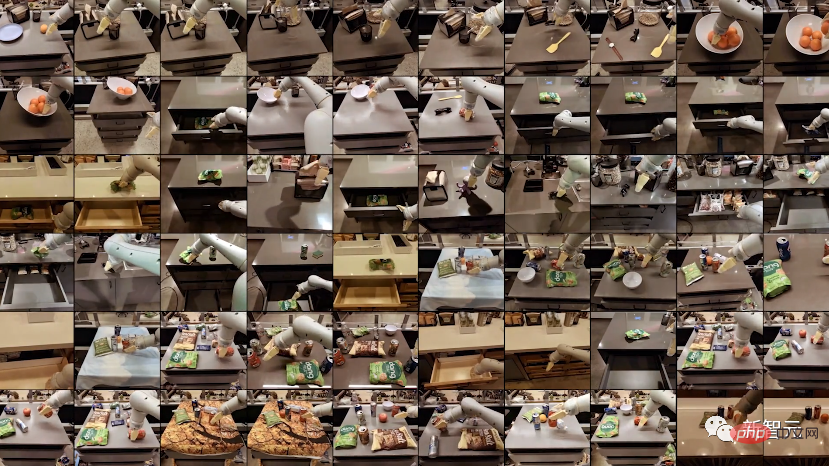
We use demonstrations provided by humans via remote operation and textual descriptions of the robot’s execution instructions for each Annotate one episode.
This robot performs tasks by relying on "an arm with 7 degrees of freedom, a two-finger gripper and a mobile base."
The set of high-level skills represented in the dataset include picking and placing items, opening and closing drawers, putting items in and out of drawers, holding long, thin items upright, and knocking objects apart. Turn over and wait for the operation.
Integrating heterogeneous data sources
To further advance RT-1, we trained it using data collected from another robot to test the (1) model whether its performance on the original task is maintained when new data sources are presented, and (2) whether the model improves in generalization with new and different data.
We transform the collected data to match the action specifications and boundaries of the original datasets we collected using EDR, and label each dataset with task instructions.
Kuka data is then mixed with EDR data in a 1:2 ratio in each training batch to control the regression of the original EDR skills.
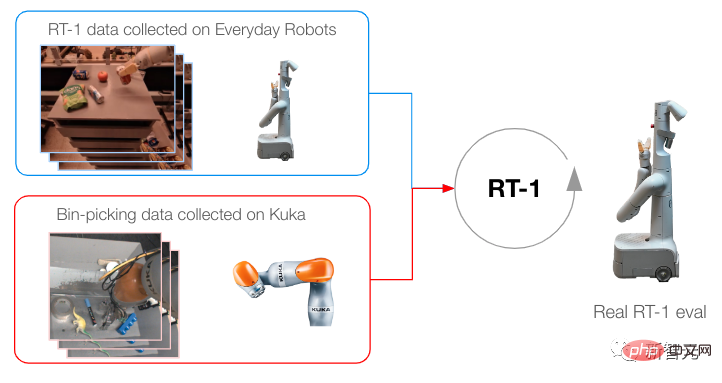
The picture shows the training method when collecting data from multiple robots
The results show that RT-1 is able to acquire new skills through the experience of observing other robots.
When RT-1 was trained on Kuka’s bin picking data and existing EDR data from the robotics classroom, there was a 22% accuracy jump when trained using only EDR data. "nearly doubled" to 39%.

Accuracy when RT-1 is trained using picking data from Kuka alone and evaluated using picking data from EDR robots is 0%.
Experimental results
To better understand the generalization ability of RT-1, we studied its performance against three baselines: Gato, BC-Z and BC-Z XL (i.e. BC-Z with the same number of parameters as RT-1).
and divide it into four categories:
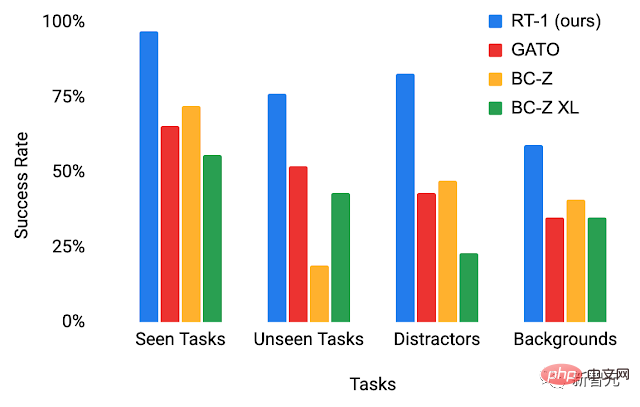
The picture shows the test environment Performance of RT-1 and control group
- Seen tasks performance (Seen tasks performance): task performance observed during training;
-
Unseen tasks performance (Unseen tasks performance): observed during training Performance on invisible tasks where skills and objects are separated in the training set;
- Robustness: during the intervention of distractors Performance and performance of background changes (new kitchen, lighting, background scenes)
- Long-horizon scenarios: Execution of SayCan-like natural language instructions in a real kitchen
RT-1’s high performance and generalization capabilities enable long-distance, mobile operation tasks through SayCan.
SayCan works by placing a language model within the robot's affordances and using a small number of prompts to break down the long-term task of expressing natural language into a series of low-level skills.
We evaluate SayCan in two real kitchens using RT-1 and two other baselines (SayCan with Gato and SayCan with BC-Z).
Below, "Kitchen2" poses a more challenging generalization scenario than "Kitchen1". The simulated kitchen used to collect most of the training data was modeled after Kitchen1.
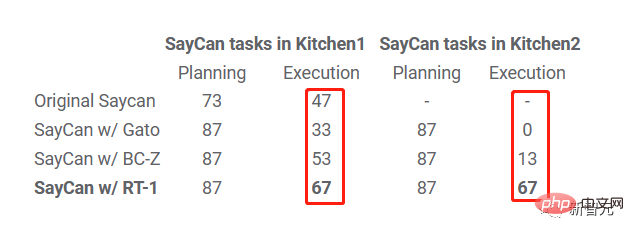
It can be seen that the execution success rate of SayCan with RT-1 in Kitchen1 is 67%, which is better than other baselines.
The performance of SayCan with Gato and SayCan with BCZ decreased due to the generalization difficulties caused by the new invisible kitchen, but the success rate of RT-1 did not decrease accordingly.
The above is the detailed content of Google RT-1 model asks a robot to do several jobs, with a success rate of 97% for 700 instructions. For more information, please follow other related articles on the PHP Chinese website!

Hot AI Tools

Undresser.AI Undress
AI-powered app for creating realistic nude photos

AI Clothes Remover
Online AI tool for removing clothes from photos.

Undress AI Tool
Undress images for free

Clothoff.io
AI clothes remover

AI Hentai Generator
Generate AI Hentai for free.

Hot Article

Hot Tools

Notepad++7.3.1
Easy-to-use and free code editor

SublimeText3 Chinese version
Chinese version, very easy to use

Zend Studio 13.0.1
Powerful PHP integrated development environment

Dreamweaver CS6
Visual web development tools

SublimeText3 Mac version
God-level code editing software (SublimeText3)

Hot Topics
 1382
1382
 52
52
 The world's most powerful open source MoE model is here, with Chinese capabilities comparable to GPT-4, and the price is only nearly one percent of GPT-4-Turbo
May 07, 2024 pm 04:13 PM
The world's most powerful open source MoE model is here, with Chinese capabilities comparable to GPT-4, and the price is only nearly one percent of GPT-4-Turbo
May 07, 2024 pm 04:13 PM
Imagine an artificial intelligence model that not only has the ability to surpass traditional computing, but also achieves more efficient performance at a lower cost. This is not science fiction, DeepSeek-V2[1], the world’s most powerful open source MoE model is here. DeepSeek-V2 is a powerful mixture of experts (MoE) language model with the characteristics of economical training and efficient inference. It consists of 236B parameters, 21B of which are used to activate each marker. Compared with DeepSeek67B, DeepSeek-V2 has stronger performance, while saving 42.5% of training costs, reducing KV cache by 93.3%, and increasing the maximum generation throughput to 5.76 times. DeepSeek is a company exploring general artificial intelligence
 AI subverts mathematical research! Fields Medal winner and Chinese-American mathematician led 11 top-ranked papers | Liked by Terence Tao
Apr 09, 2024 am 11:52 AM
AI subverts mathematical research! Fields Medal winner and Chinese-American mathematician led 11 top-ranked papers | Liked by Terence Tao
Apr 09, 2024 am 11:52 AM
AI is indeed changing mathematics. Recently, Tao Zhexuan, who has been paying close attention to this issue, forwarded the latest issue of "Bulletin of the American Mathematical Society" (Bulletin of the American Mathematical Society). Focusing on the topic "Will machines change mathematics?", many mathematicians expressed their opinions. The whole process was full of sparks, hardcore and exciting. The author has a strong lineup, including Fields Medal winner Akshay Venkatesh, Chinese mathematician Zheng Lejun, NYU computer scientist Ernest Davis and many other well-known scholars in the industry. The world of AI has changed dramatically. You know, many of these articles were submitted a year ago.
 Hello, electric Atlas! Boston Dynamics robot comes back to life, 180-degree weird moves scare Musk
Apr 18, 2024 pm 07:58 PM
Hello, electric Atlas! Boston Dynamics robot comes back to life, 180-degree weird moves scare Musk
Apr 18, 2024 pm 07:58 PM
Boston Dynamics Atlas officially enters the era of electric robots! Yesterday, the hydraulic Atlas just "tearfully" withdrew from the stage of history. Today, Boston Dynamics announced that the electric Atlas is on the job. It seems that in the field of commercial humanoid robots, Boston Dynamics is determined to compete with Tesla. After the new video was released, it had already been viewed by more than one million people in just ten hours. The old people leave and new roles appear. This is a historical necessity. There is no doubt that this year is the explosive year of humanoid robots. Netizens commented: The advancement of robots has made this year's opening ceremony look like a human, and the degree of freedom is far greater than that of humans. But is this really not a horror movie? At the beginning of the video, Atlas is lying calmly on the ground, seemingly on his back. What follows is jaw-dropping
 KAN, which replaces MLP, has been extended to convolution by open source projects
Jun 01, 2024 pm 10:03 PM
KAN, which replaces MLP, has been extended to convolution by open source projects
Jun 01, 2024 pm 10:03 PM
Earlier this month, researchers from MIT and other institutions proposed a very promising alternative to MLP - KAN. KAN outperforms MLP in terms of accuracy and interpretability. And it can outperform MLP running with a larger number of parameters with a very small number of parameters. For example, the authors stated that they used KAN to reproduce DeepMind's results with a smaller network and a higher degree of automation. Specifically, DeepMind's MLP has about 300,000 parameters, while KAN only has about 200 parameters. KAN has a strong mathematical foundation like MLP. MLP is based on the universal approximation theorem, while KAN is based on the Kolmogorov-Arnold representation theorem. As shown in the figure below, KAN has
 How can AI make robots more autonomous and adaptable?
Jun 03, 2024 pm 07:18 PM
How can AI make robots more autonomous and adaptable?
Jun 03, 2024 pm 07:18 PM
In the field of industrial automation technology, there are two recent hot spots that are difficult to ignore: artificial intelligence (AI) and Nvidia. Don’t change the meaning of the original content, fine-tune the content, rewrite the content, don’t continue: “Not only that, the two are closely related, because Nvidia is expanding beyond just its original graphics processing units (GPUs). The technology extends to the field of digital twins and is closely connected to emerging AI technologies. "Recently, NVIDIA has reached cooperation with many industrial companies, including leading industrial automation companies such as Aveva, Rockwell Automation, Siemens and Schneider Electric, as well as Teradyne Robotics and its MiR and Universal Robots companies. Recently,Nvidiahascoll
 Tesla robots work in factories, Musk: The degree of freedom of hands will reach 22 this year!
May 06, 2024 pm 04:13 PM
Tesla robots work in factories, Musk: The degree of freedom of hands will reach 22 this year!
May 06, 2024 pm 04:13 PM
The latest video of Tesla's robot Optimus is released, and it can already work in the factory. At normal speed, it sorts batteries (Tesla's 4680 batteries) like this: The official also released what it looks like at 20x speed - on a small "workstation", picking and picking and picking: This time it is released One of the highlights of the video is that Optimus completes this work in the factory, completely autonomously, without human intervention throughout the process. And from the perspective of Optimus, it can also pick up and place the crooked battery, focusing on automatic error correction: Regarding Optimus's hand, NVIDIA scientist Jim Fan gave a high evaluation: Optimus's hand is the world's five-fingered robot. One of the most dexterous. Its hands are not only tactile
 FisheyeDetNet: the first target detection algorithm based on fisheye camera
Apr 26, 2024 am 11:37 AM
FisheyeDetNet: the first target detection algorithm based on fisheye camera
Apr 26, 2024 am 11:37 AM
Target detection is a relatively mature problem in autonomous driving systems, among which pedestrian detection is one of the earliest algorithms to be deployed. Very comprehensive research has been carried out in most papers. However, distance perception using fisheye cameras for surround view is relatively less studied. Due to large radial distortion, standard bounding box representation is difficult to implement in fisheye cameras. To alleviate the above description, we explore extended bounding box, ellipse, and general polygon designs into polar/angular representations and define an instance segmentation mIOU metric to analyze these representations. The proposed model fisheyeDetNet with polygonal shape outperforms other models and simultaneously achieves 49.5% mAP on the Valeo fisheye camera dataset for autonomous driving
 The latest from Oxford University! Mickey: 2D image matching in 3D SOTA! (CVPR\'24)
Apr 23, 2024 pm 01:20 PM
The latest from Oxford University! Mickey: 2D image matching in 3D SOTA! (CVPR\'24)
Apr 23, 2024 pm 01:20 PM
Project link written in front: https://nianticlabs.github.io/mickey/ Given two pictures, the camera pose between them can be estimated by establishing the correspondence between the pictures. Typically, these correspondences are 2D to 2D, and our estimated poses are scale-indeterminate. Some applications, such as instant augmented reality anytime, anywhere, require pose estimation of scale metrics, so they rely on external depth estimators to recover scale. This paper proposes MicKey, a keypoint matching process capable of predicting metric correspondences in 3D camera space. By learning 3D coordinate matching across images, we are able to infer metric relative



